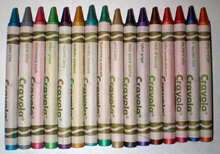| Bronze | |
|---|---|
| Hex triplet | #CD7F32 |
| sRGBB (r, g, b) | (205, 127, 50) |
| HSV (h, s, v) | (30°, 76%, 80%) |
| CIELChuv (L, C, h) | (60, 81, 39°) |
| Source | [1]/Maerz and Paul[1] |
| ISCC–NBS descriptor | Strong orange |
| B: Normalized to [0–255] (byte) | |

Bronze is a metallic brown color which resembles the metal alloy bronze.

The first recorded use of bronze as a color name in English was in 1753.[2]
Variations
[edit]Blast-off bronze
[edit]| Blast-Off Bronze | |
|---|---|
| Hex triplet | #A57164 |
| sRGBB (r, g, b) | (165, 113, 100) |
| HSV (h, s, v) | (12°, 39%, 65%) |
| CIELChuv (L, C, h) | (53, 39, 24°) |
| Source | Crayola |
| ISCC–NBS descriptor | Light reddish brown |
| B: Normalized to [0–255] (byte) | |
Blast-off bronze is one of the colors in the special set of metallic Crayola crayons called Metallic FX, the colors of which were formulated by Crayola in 2001.

Antique bronze
[edit]| Antique Bronze | |
|---|---|
| Hex triplet | #665D1E |
| sRGBB (r, g, b) | (102, 93, 30) |
| HSV (h, s, v) | (52°, 71%, 40%) |
| CIELChuv (L, C, h) | (39, 37, 77°) |
| Source | ISCC-NBS |
| ISCC–NBS descriptor | Moderate olive |
| B: Normalized to [0–255] (byte) | |
The first recorded use of antique bronze as a color name in English was in 1910.[3]

References
[edit]- ^ The colour displayed in the colour box above matches the colour called bronze, in the 1930 book by Maerz and Paul, A Dictionary of Color, New York: 1930 McGraw-Hill; the colour bronze is displayed on page 51, Plate 14, Colour Sample L9.
- ^ Maerz and Paul, A Dictionary of Color, New York: 1930 McGraw-Hill, p. 191; Colour Sample of Bronze: p. 51, Plate 14, Colour Sample L9
- ^ Maerz and Paul, A Dictionary of Color, New York: 1930 McGraw-Hill; p. 189, Color Sample of Bronze: p. 51, Plate 14, Color Sample L10

Well, that’s interesting to know that Psilotum nudum are known as whisk ferns. Psilotum nudum is the commoner species of the two. While the P. flaccidum is a rare species and is found in the tropical islands. Both the species are usually epiphytic in habit and grow upon tree ferns. These species may also be terrestrial and grow in humus or in the crevices of the rocks.
View the detailed Guide of Psilotum nudum: Detailed Study Of Psilotum Nudum (Whisk Fern), Classification, Anatomy, Reproduction